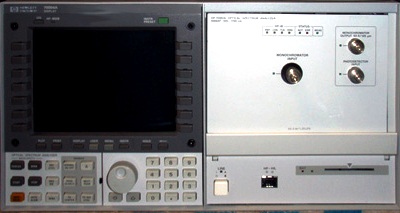
|
|
The HP 71452B is a diffraction-grating based optical spectrum analyzer (OSA). Each analyzer consists of a 70004A mainframe/color display and the 70952B OSA module. The HP 71452B contains enhanced optical components for excellent accuracy in characterizing optical amplifiers. Using a unique double-pass monochromator design which offers the dynamic range of a double monochromator and the sensitivity of a single monochromator. The OSA performs quick, precise spectral measurements from 600 to 1700 nm. It offers critical measurement capabilities needed in the laboratory and on the production floor. The HP 71452B provides unprecedented performance with their outstanding dynamic range, sensitivity, high amplitude and wavelength accuracy, and polarization insensitivity. It performs measurements quickly, especially when high sensitivity is required. Capable of sweeping 40 nm in 50 ms with reduced dead time, the analyzer can save hours of measurement time. In addition, the HP 71452B can be left continually sweeping; you no longer need to stop the sweep to save wear and avoid costly repairs. Wavelength range: 600 nm to 1700. Wavelength Tuning repeatability: ±0.005 nm. Wavelength Span Range: 0.2 nm to full range and zero span. Wavelength Absolute Accuracy: ±1 nm. Flatness: 1530 nm - 1570 nm, ±0.25 dB; 1250 nm - 1600 nm, ±1 dB. Maximum Sensitivity (1100-1600 nm): –90 dBm. Maximum Sweep Rate: 40 nm/50 ms. Max Measurement Power: + 20 dBm per 5 nm, +30 dBm total. Dynamic Range in 0.1 nm resolution: -50 dB at = ± 1 nm. Resolution Bandwidth: 0.08 nm, 0.1 nm, 0.2 nm, 0.5 nm, 1 nm, 2 nm, 5 nm, 10 nm. Signal-to-Noise Measurement: CW ± 0.18 dB, Pulse mode ± 0.29 dB. 1 MB memory and FC/PC connectors are standard. Options. Opt 001 Programmable Current Source. Opt 002 Built-in White Light Source. Opt 031 DWDM Component Test Kit.
|